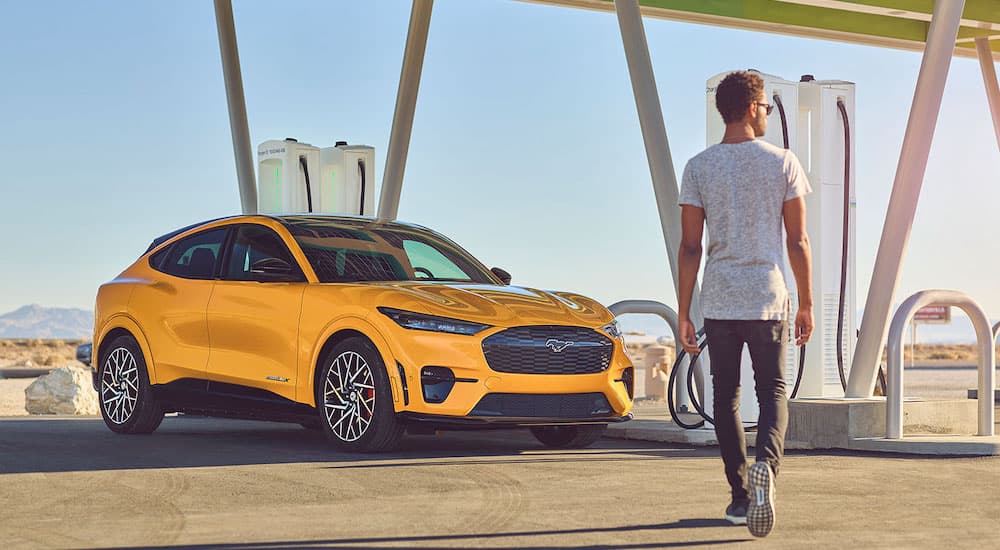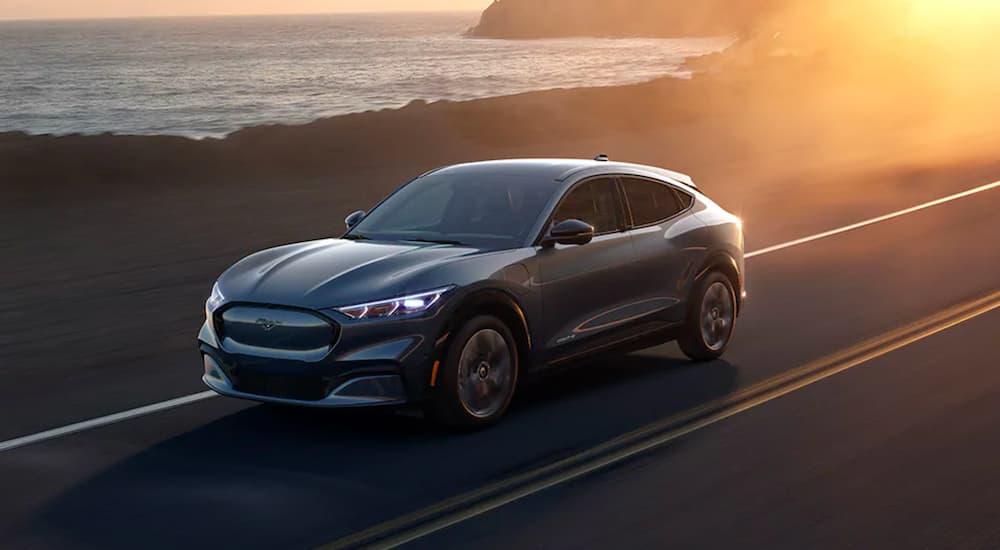Buying your first electric vehicle (EV) is an exciting prospect—but like many drivers, you might find yourself hesitating. While you might have been intimidated by the price years ago, you’ll notice that EV vehicles are more affordable today than ever before, thanks mostly to a decrease in the cost of lithium-ion batteries. Despite this relief, another worry still lingers: the fear around battery life and charging.
Search for ‘EVs for sale near me‘ and you’ll find a number of different models, with some of the best being by Ford. The Blue Oval is at the forefront of EVs, producing some of the most affordable and reliable—not to mention good-looking—electric vehicles on the market. From the F-150 Lightning to the eye-catching Mach-E crossover, finding an affordable EV to meet your needs isn’t the problem. Oftentimes consumers’ concerns center around the battery: the ease of charging, maintenance costs, how long the battery lasts, and what happens if you run out of charge on the road.
These are all valid concerns. Drivers looking for a new EV will be happy to hear that EVs have come a long way, even in the last five years, with charging now as easy as charging your phone. With expanding technology and a growing number of public charging stations, going green is easier than ever.
If you’re ready to make the change, don’t let unnecessary barriers like the worry of charging or maintenance prevent you from reducing your carbon footprint. Alleviate your concerns by reading this handy guide and making the leap from gas to electric go as smoothly as possible.
Ford’s EV Battery
One of the initial reasons EVs were so expensive was the lithium-ion battery. These high costs were the primary bump in the road preventing EVs from going mainstream. Besides the original lithium-ion battery’s tendency to overheat and even go up in flames, many of the raw materials needed for the battery were sourced from nations like the Republic of Congo, which are in the middle of a humanitarian crisis. However, Ford is one of the many automakers that has sought to change things up in a big way.
Ford is committed to bringing EVs to the mass market, aiming to produce more than two million EVs by 2026. One way to do this is to readjust and update the lithium-ion battery to the lithium-iron-phosphate formula or LFP (for lithium ferrophosphate). This formula was introduced by Tesla just last year, with Ford quickly adopting the update.
Ford announced in 2022 that it would begin construction on the BlueOval Battery Park, Michigan, with plans to produce its own LFP batteries for its electric vehicles. Ford will continue to integrate LFP batteries into its future lineups. Besides their plans to produce a fifth-generation lithium-ion battery, Ford also focuses on solid-state batteries, meaning this is not only better ethically but also means consumers will get more battery choices in the future.
At the moment, Ford—in partnership with SK, together as BlueOvalSK—is manufacturing batteries that produce around 60 GWh, but by 2023 they hope to expand this to 140 GWh for the North American market.

Charging With Ford
Now that you have a little background on Ford and its batteries, what about the everyday basics for drivers? Well, we’re here to say you have nothing to worry about. Charging a vehicle nowadays is on par with charging a laptop or phone: it’s quick, easy, and something anyone can do.
Ford offers several charging options for its EVs, but the most popular method is likely with their at-home units. Each new Ford EV comes with a switchable at-home charging station: a 120V or 240V Ford Mobile Charger or a 240V/48A hardwired Ford Connect Charge Station. Having the expert-installed Ford Connect Charge Station will handily net you the fastest at-home charges.
There is also the option of the Ford Mobile Charger cord, which allows you to simply plug in your vehicle to a standard 120V or 240V wall outlet and charge up. If you’re not at home or have multiple vehicles that need charging, the Ford Mobile Charger cord adds flexibility to your charging options.
The pace at which your EV charges depends on the model and the method you choose. While it’s feasible to charge your battery overnight, a full charge can be quicker or longer to achieve, depending on whether you go for the 120V or 240V Mobile Charger or the Connect Charge Station. Consult with an installation expert to ensure you’re getting the option that works for you.
When you’re on the road, the Blue Oval Charge Network is ready for you to pull through; this web of 25,000+ public charging stations across North America is constantly growing. The network also includes 4,000+ DC Fast Charging stations for an even quicker boost of power.
Drivers can find the charging station nearest to them—or ones along their route—using the FordPass App. This lets you plan your route so you know all the places you can stop to charge. You can also eliminate the need for credit cards or even smartphones thanks to Ford’s Plug & Charge technology.
EVs on the Road
What happens if you run out of juice on the road? This is one of the most asked questions when it comes to EVs. After all, you can WALK to a gas station—but what about a charging station? How does that work? Don’t worry, future drivers of EVs, because Ford has your back. Ford offers free roadside assistance for drivers for up to five years or 60,000 miles (whichever comes first) after purchase. Access to Ford’s roadside assistance is made easy through the FordPass App.
Ford EVs are equipped with multiple alerts to warn drivers about their battery levels and potential problems; however, sometimes things can’t be avoided, but Ford is there to take the edge off. If your battery happens to run out while you’re on the road, Ford has three options for drivers: they can help you get to the nearest certified Ford dealer, they can tow you to the nearest charging station (within 50 miles of your location), or they can tow you to your home. The latter assumes you have the ability to charge at home; if, for some reason, you can’t charge at home (for example, there’s a power outage) or you’re 50 miles or more from your home, you’ll be referred to the other two options.
Ford also offers roadside assistance benefits that cover costs and will reimburse you if needed, such as if you paid for a tow because you weren’t aware you were currently covered by Ford’s Roadside Assistance program or if you were locked out of your vehicle and had to pay for a locksmith to help you. If you’re covered under Ford, they will assist you in unlocking your vehicle at no charge.

While EV batteries have a general lifespan of eight to twenty years, with battery packs lasting around 100,000 to 200,000 miles, things like heat, seasonal temperatures, manufacturer, and storage can all play a part in its overall lifespan. The best bet when driving any vehicle—EV or not—is to make sure you stay up to date with alerts and routine service appointments (this can be easily done through the FordPass App) to ensure that your vehicle is in top shape so that no issues come up when you’re on the go.
As for maintenance costs, potential EV buyers will enjoy how EVs aren’t just getting more affordable to buy but more affordable to maintain. In fact, EVs generally cost less than traditional vehicles to maintain; EV drivers can expect to pay around $45 a month versus a gas-powered vehicle that can cost upwards of $100 a month. Over its lifetime, you can expect the common EV to cost you around $4,600 in general maintenance costs versus $9,200 for a traditional gas-engine vehicle. As you can see, the savings clearly add up when you choose to go electric.
Go Farther, Go Green
Are you feeling better about the idea of making the switch from gas to electric? As you can see, the case is strong for the future of electric vehicles, with more automakers slowly transitioning to an all-hybrid/EV lineup. We also love the fact that prices for EVs are coming down more and more each year, making them increasingly accessible. And the best part? These vehicles are easy to operate, own, and maintain, often costing less than their gas counterpart.
Drivers in the market for a dependable car with zero emissions can count on Ford and its ever-expending lineup of premium EVs. Thanks to Ford’s innovative and thoughtful designs, deciding to get behind the wheel of your next EV will be a no-brainer. So if you’re ready to make the switch, go green with the Blue Oval.

